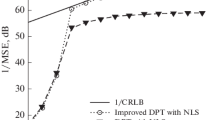Abstract
The offered method of the amplitude-phase-modulated signal spectrum calculation is described. Using the known and offered methods of spectrum calculation, the signals obtained in case of use of range of known and new varieties of phase and amplitude-phase modulation were researched. It is shown, that the offered method ensure a high precision and reduction of research duration in case of spectrum calculation of such signals in comparison with the known methods of spectrum calculation.
Similar content being viewed by others
References
Miaja, P.F., Rodriguez, A., Sebastian, J., and Ayestaran, R.G., On the estimation of the spectrum of discrete pulsewidth modulated signals, Proc. IEEE 15th Workshop on Control and Modeling for Power Electronics (COMPEL), 2014, pp. 1–10.
Verbytskyi, I., Spectrum calculation of frequency pulse modulation voltage using double Fourier series, Proc. IEEE 3rd Workshop on Advances in Information, Electronic and Electrical Engineering (AIEEE), 2015, pp. 1–4.
Wang, R., Zhang, Y., and Guo, J., Power harmonic analysis based on Orthogonal Trigonometric Functions Family, Proc. China International Conference on Electricity Distribution (CICED), 2010, pp. 1–7.
Bremaud, P., and Ridolfi, A., Power spectra of UWB time-hopping modulated signals: A shot noise approach, Proc. Int. Symposium on Information Theory (ISIT), 2004, p. 382.
Chi, Sh., Vogel, Ch., and Singerl, P., The frequency spectrum of polar modulated PWM signals and the image problem, 17th IEEE Int. Conf. on Electronics, Circuits, and Systems (ICECS), 2010, pp. 679–682.
Sklar, B., Digital Communications. Fundamentals and Applications, Upper Sadle River, New Jersey: Prentice Hall, 2001, 2nd ed.
Simon, M.K., Bandwidth-Efficient Digital Modulation with Application to Deep-Space Communications, Yuen, J.H., ed., Jet Propulsion Labor. California Inst. Technol., 2001.
Proakis, J., Digital Communications, New York: McGraw-Hill, 2001, 4th ed.
Feher, K., Wireless Digital Communications. Modulation and Spread Spectrum Applications, Upper Sadle River, New Jersey: Prentice Hall, 1995.
Luise, M., Easy calculation of power spectra for multi-h phase-coded signals, Electron. Lett., 1985, vol. 21, no. 14, pp. 608–609.
Mandziy, B.A. and Bench, A., Energy spectrums of signals that present the Ukrainian linguistic texts, Visn. Nat. Univ. L’viv. Politekh., 2009, no. 645, pp. 157–161.
Gorbatyy, I.V., Systemy dystantciynoho zonduvannja Zemli z kosmosu: Monohrafija (Systems of the Remote Sensing of Earth from Space: Monograph), Lviv: SPOLOM, 2011.
Gorbatyy, I.V., Ukraine Patent 91942, Byull. Izobret., 2010, no. 17.
Gorbatyy, I.V., Investigation of the technical efficiency of state-of-the-art telecommunication systems and networks with limited bandwidth and signal power, Autom. Control Comput. Sci., 2014, vol. 48, no. 1, pp. 47–55.
Baskakov, S.I., Radiotekhnicheskie tsepi i signaly: Uchebnik dlya vuzov (The Radio Engineering Chains and Signals: A Handbook for High Education Institutes), Moscow: Vysshaya Shkola, 1983.
Galkin, V.A., Mobil’naya svyaz’: Uchebnoe posobie dlya vuzov (Mobile Communications: A Handbook for High Education Institutes), Moscow: Goryachaja Linija-Telecom, 2007.
Mandziy, B.A., Osnovy teoriji sygnaliv: Pidruchnyk (Bases of Theory of Signals: A Handbook for High Education Institutes), Mandziy, B.A., Jeljak, R.I., and Mandziy, B.A., Eds., Lviv: Vydavnychyi Dim “Iniciatyva,” 2008.
Losev, A.K., Teoriya lineinykh elektricheskih tsepei: Uchebnik dlya vuzov (Theory of Linear Electric Chains: A Handbook for High Education Institutes), Moscow: Vysshaja Shkola, 1987.
Gonorovskij, I.S., Radiotekhnicheskie tsepi i signaly: Uchebnik dlya vuzov (The Radio Engineering Chains and Signals: A Handbook for High Education Institutes), Moscow: Radio i Svyaz’, 1986.
Author information
Authors and Affiliations
Corresponding author
Additional information
The article is published in the original.
About this article
Cite this article
Horbatyi, I.V. Research of Theoretical Methods Precision of the Amplitude-Phase-Modulated Signal Spectrum Calculation. Aut. Control Comp. Sci. 52, 100–108 (2018). https://doi.org/10.3103/S0146411618020037
Received:
Accepted:
Published:
Issue Date:
DOI: https://doi.org/10.3103/S0146411618020037




